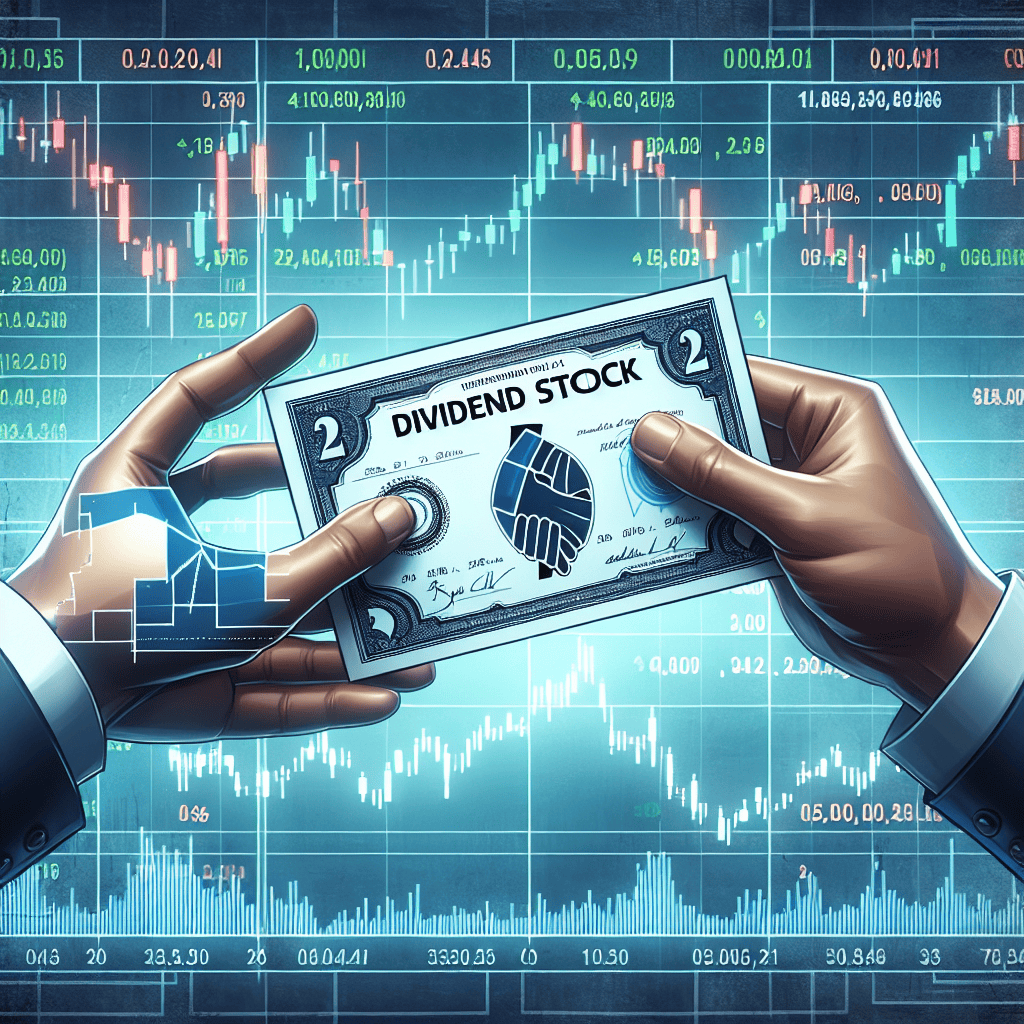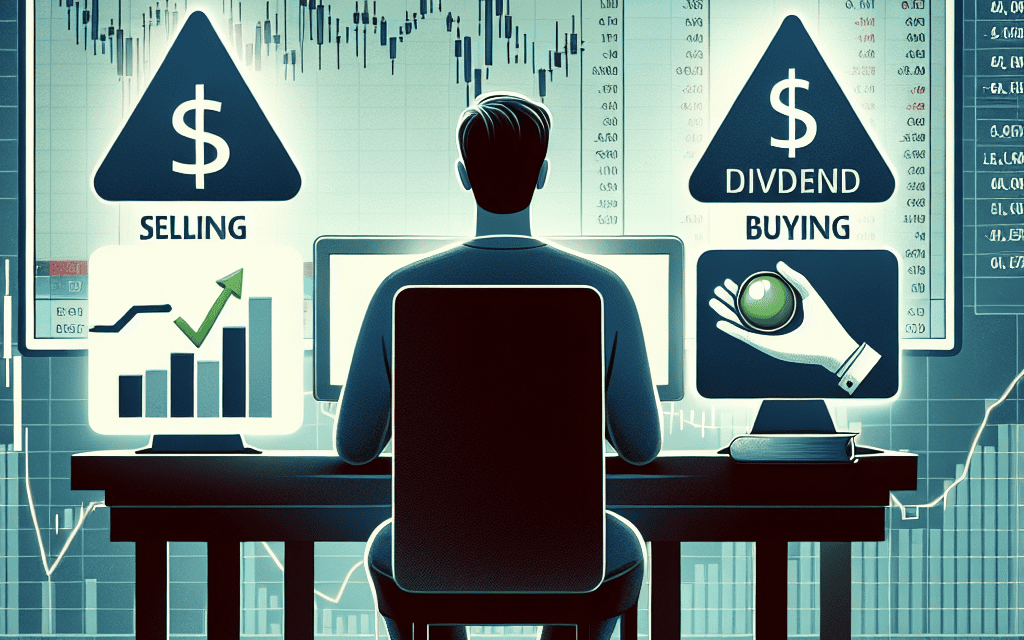“Unlocking Growth: My Strategic Shift from Steady Dividends to Dynamic Opportunities”
Introduction
In the ever-evolving landscape of investment opportunities, dividend stocks have long been a cornerstone for investors seeking both income and growth. Recently, I made the strategic decision to trade two popular dividend stocks, driven by a combination of market analysis, financial performance, and future growth potential. This decision was not made lightly, as it involved a careful evaluation of the companies’ dividend yields, payout ratios, and overall financial health. By examining these factors, I aimed to optimize my portfolio for both stability and potential capital appreciation, ensuring that my investment strategy aligns with my long-term financial goals.
Market Volatility Impact on Dividend Stocks
In the ever-evolving landscape of financial markets, investors are constantly faced with the challenge of navigating market volatility, which can significantly impact the performance of dividend stocks. Recently, I made the decision to trade two popular dividend stocks, a move driven by the increasing unpredictability in the market. This decision was not made lightly, as dividend stocks are often considered a cornerstone of a stable investment portfolio, providing a steady income stream even during turbulent times. However, the current market conditions have prompted a reevaluation of their role in my investment strategy.
To begin with, it is essential to understand the nature of market volatility and its implications for dividend stocks. Market volatility refers to the rate at which the price of securities increases or decreases for a given set of returns. High volatility often indicates uncertainty and can lead to significant price swings, which may affect the stability of dividend payouts. In recent months, several factors have contributed to heightened market volatility, including geopolitical tensions, fluctuating interest rates, and economic uncertainties. These elements have created an environment where the reliability of dividend stocks is increasingly questioned.
One of the stocks I decided to trade was a well-known utility company, traditionally seen as a safe haven for dividend investors due to its stable cash flows and consistent dividend payments. However, the rising interest rates have put pressure on utility companies, as their capital-intensive nature makes them sensitive to borrowing costs. As interest rates climb, the cost of debt increases, potentially squeezing profit margins and affecting the company’s ability to maintain its dividend payouts. Consequently, the once-stable utility stock began to exhibit signs of vulnerability, prompting me to reconsider its place in my portfolio.
Similarly, I chose to trade a prominent consumer goods company, another staple in the dividend stock arena. While consumer goods companies are generally resilient to economic downturns due to the non-discretionary nature of their products, recent supply chain disruptions and inflationary pressures have posed significant challenges. These issues have led to increased operational costs, which can erode profit margins and, in turn, impact the company’s capacity to sustain its dividend payments. As these challenges persist, the risk associated with holding this stock has increased, leading me to seek alternatives that offer a more favorable risk-reward profile.
In light of these considerations, it became apparent that maintaining a diversified portfolio is crucial in mitigating the risks associated with market volatility. By reallocating my investments into sectors and stocks that are better positioned to withstand current market conditions, I aim to preserve the stability and growth potential of my portfolio. This strategic shift does not imply a complete abandonment of dividend stocks but rather a selective approach to identifying those with strong fundamentals and a proven track record of weathering economic storms.
In conclusion, the decision to trade these two popular dividend stocks was driven by the need to adapt to the changing market environment. While dividend stocks remain an integral part of my investment strategy, it is imperative to remain vigilant and responsive to market dynamics. By doing so, I can better navigate the challenges posed by market volatility and continue to achieve my long-term financial goals.
Dividend Yield Versus Growth Potential
In the ever-evolving landscape of investment, the decision to trade dividend stocks often hinges on a delicate balance between dividend yield and growth potential. Recently, I made the decision to trade two popular dividend stocks, a choice driven by a strategic reassessment of my portfolio’s long-term objectives. This decision was not made lightly, as both stocks had been reliable sources of income. However, the shifting dynamics of the market and the evolving needs of my investment strategy necessitated a reevaluation of their roles within my portfolio.
To begin with, dividend yield is a critical factor for many investors, particularly those seeking a steady income stream. The allure of high dividend yields can be compelling, offering the promise of regular returns. However, it is essential to consider the sustainability of these dividends. In recent months, I observed that one of the stocks, despite its attractive yield, was facing challenges that could potentially impact its ability to maintain its dividend payouts. The company’s financial health was under scrutiny, with rising debt levels and declining revenue growth. These red flags prompted me to question the long-term viability of its dividend policy.
On the other hand, growth potential is an equally important consideration. While dividend stocks are often associated with stability, they can sometimes lack the dynamism of growth stocks. The second stock in question, although a consistent dividend payer, was showing signs of stagnation in its core business operations. The industry it operated in was undergoing significant transformation, with new technologies and competitors reshaping the landscape. Despite its strong historical performance, the company’s growth prospects appeared limited, and its ability to adapt to these changes was uncertain.
In light of these observations, I decided to trade these stocks in favor of opportunities that offered a more balanced combination of yield and growth. This decision was further reinforced by the broader economic environment. With interest rates on the rise and inflationary pressures mounting, the need for investments that could potentially outpace inflation became more pressing. Consequently, I sought out stocks with robust growth trajectories and the potential for capital appreciation, even if it meant accepting a slightly lower dividend yield in the short term.
Moreover, diversification played a crucial role in my decision-making process. By reallocating my investments, I aimed to achieve a more diversified portfolio that could better withstand market volatility. This approach not only mitigates risk but also positions the portfolio to capitalize on emerging trends and sectors poised for growth. The transition from high-yield dividend stocks to those with greater growth potential reflects a strategic shift towards a more dynamic investment strategy.
In conclusion, the decision to trade these two popular dividend stocks was driven by a comprehensive analysis of dividend yield versus growth potential. While high yields can be enticing, they must be weighed against the sustainability of the dividends and the company’s growth prospects. By prioritizing a balanced approach that considers both income and growth, I am better positioned to achieve my long-term investment goals. This strategic realignment underscores the importance of regularly reassessing one’s portfolio in response to changing market conditions and personal financial objectives.
Sector-Specific Risks and Opportunities
In the ever-evolving landscape of investment, the decision to trade stocks is often influenced by a myriad of factors, including sector-specific risks and opportunities. Recently, I made the decision to trade two popular dividend stocks, a move driven by a careful analysis of the sectors they belong to and the potential risks and opportunities inherent within them. This decision was not made lightly, as dividend stocks are typically valued for their ability to provide a steady income stream. However, the dynamic nature of the market necessitates a proactive approach to portfolio management.
The first stock I traded was from the utilities sector, a sector traditionally known for its stability and reliable dividend payouts. Utilities are often considered a safe haven for conservative investors, given their essential nature and regulated environment. However, recent developments have introduced a level of uncertainty that prompted me to reassess my position. The increasing push towards renewable energy and the subsequent regulatory changes pose significant challenges for traditional utility companies. While some companies are adapting by investing in renewable infrastructure, the transition is fraught with financial and operational risks. Moreover, the rising interest rates have increased the cost of capital, further straining the financial health of these companies. Consequently, the potential for reduced profitability and dividend cuts became a concern, leading me to divest from this particular stock.
In contrast, the second stock I traded was from the consumer staples sector, which is often lauded for its resilience during economic downturns. Companies in this sector produce essential goods, ensuring a consistent demand regardless of economic conditions. However, the current economic climate presents unique challenges that could impact their performance. Inflationary pressures have led to increased production costs, which companies may struggle to pass on to consumers without affecting demand. Additionally, supply chain disruptions continue to pose significant operational challenges, potentially impacting the ability to maintain profit margins. While consumer staples companies have historically managed to navigate such challenges, the current confluence of factors presents a heightened risk that could affect their ability to sustain dividend payouts. This assessment led me to conclude that reallocating my investment to sectors with more favorable risk-reward profiles was a prudent decision.
In making these trades, I sought to capitalize on emerging opportunities in sectors poised for growth. The technology sector, for instance, offers promising prospects driven by rapid innovation and digital transformation across industries. Companies within this sector are not only expanding their market reach but also enhancing operational efficiencies, thereby improving profitability. Similarly, the healthcare sector presents compelling opportunities, particularly in the areas of biotechnology and pharmaceuticals, where advancements in research and development are paving the way for groundbreaking treatments and therapies. By redirecting my investments towards these sectors, I aim to achieve a balanced portfolio that not only mitigates risk but also positions itself for potential growth.
In conclusion, the decision to trade these two popular dividend stocks was informed by a thorough analysis of sector-specific risks and opportunities. While dividend stocks remain an integral part of my investment strategy, adapting to the changing market landscape is essential for long-term success. By staying informed and responsive to emerging trends, I am better equipped to navigate the complexities of the investment world and optimize my portfolio for future growth.
Portfolio Diversification Strategy

In the ever-evolving landscape of investment, portfolio diversification remains a cornerstone strategy for mitigating risk and enhancing potential returns. Recently, I made the decision to trade two popular dividend stocks, a move that may seem counterintuitive given their reputation for providing steady income. However, this decision was driven by a strategic reassessment of my portfolio’s diversification needs and the broader market conditions.
To begin with, dividend stocks are often lauded for their ability to generate passive income, making them a staple in many investment portfolios. They are typically associated with established companies that have a history of stable earnings and a commitment to returning capital to shareholders. However, while these attributes are undoubtedly appealing, they can also lead to a concentration of risk if not carefully managed. In my case, I noticed that a significant portion of my portfolio was heavily weighted towards dividend-paying stocks in similar sectors, which inadvertently increased my exposure to sector-specific risks.
Recognizing this, I embarked on a comprehensive review of my investment strategy, focusing on the need for greater diversification. This process involved analyzing the correlation between the stocks in my portfolio and identifying areas where I could reduce overlap. It became apparent that by holding onto these two particular dividend stocks, I was not only limiting my exposure to other growth opportunities but also potentially compromising the overall balance of my portfolio.
Moreover, the current economic climate played a crucial role in my decision-making process. With interest rates on the rise and inflationary pressures mounting, the traditional appeal of dividend stocks as a hedge against market volatility has been somewhat diminished. In such an environment, the opportunity cost of holding onto these stocks became more pronounced, prompting me to explore alternative investments that could offer both growth potential and diversification benefits.
Transitioning away from these dividend stocks allowed me to reallocate capital into sectors and asset classes that were underrepresented in my portfolio. For instance, I increased my exposure to technology and renewable energy stocks, which not only provided diversification but also aligned with long-term growth trends. Additionally, I explored international markets, seeking opportunities in emerging economies that offer a different risk-return profile compared to domestic dividend stocks.
This strategic shift was not without its challenges. Selling well-established dividend stocks required careful consideration of the potential tax implications and the impact on my portfolio’s income stream. However, by taking a long-term view and focusing on the broader benefits of diversification, I was able to navigate these challenges effectively.
In conclusion, while dividend stocks remain an integral part of many investment strategies, it is essential to periodically reassess their role within the context of a diversified portfolio. By trading these two popular dividend stocks, I was able to enhance my portfolio’s diversification, reduce sector-specific risks, and position myself to capitalize on emerging growth opportunities. This experience underscores the importance of adaptability in investment strategy, particularly in response to changing market conditions and personal financial goals. As investors, we must remain vigilant and open to re-evaluating our portfolios to ensure they continue to align with our long-term objectives.
Company Financial Health and Dividend Sustainability
In the realm of dividend investing, the allure of consistent income often draws investors to popular dividend stocks. However, the sustainability of these dividends is intrinsically linked to the financial health of the issuing companies. Recently, I made the decision to trade two well-known dividend stocks, driven by concerns over their financial stability and the long-term viability of their dividend payouts. This decision was not made lightly, as it required a thorough analysis of each company’s financial statements, market position, and future prospects.
To begin with, the first company in question had been a staple in my portfolio for several years, consistently providing a reliable stream of income. However, upon closer examination of its financial health, several red flags emerged. The company’s debt levels had been steadily increasing, a trend that was not matched by a corresponding growth in revenue. This imbalance raised concerns about the company’s ability to service its debt while maintaining its dividend payments. Furthermore, the payout ratio, which measures the proportion of earnings paid out as dividends, had climbed to unsustainable levels. A high payout ratio can indicate that a company is paying out more in dividends than it can afford, potentially jeopardizing future payments.
In addition to these financial metrics, the company’s market position was also under pressure. Increased competition and changing industry dynamics had begun to erode its market share, leading to a decline in profitability. This situation was exacerbated by management’s lack of a clear strategic plan to address these challenges. Without a robust strategy to regain its competitive edge, the company’s long-term growth prospects appeared bleak, further casting doubt on the sustainability of its dividend.
Similarly, the second company I traded faced its own set of financial challenges. While it had a strong history of dividend payments, recent earnings reports revealed a troubling trend of declining profits. This decline was partly due to external factors, such as unfavorable economic conditions and regulatory changes, which had adversely impacted its core business operations. Moreover, the company’s cash flow statements indicated a tightening liquidity position, raising concerns about its ability to fund both operational needs and dividend commitments.
Another critical factor influencing my decision was the company’s capital allocation strategy. Instead of reinvesting profits into growth initiatives or strengthening its balance sheet, the company had prioritized dividend payments and share buybacks. While these actions can be attractive to shareholders in the short term, they can also undermine a company’s financial health if not balanced with investments in future growth. This short-sighted approach suggested a lack of foresight in navigating the evolving market landscape, further diminishing confidence in the company’s dividend sustainability.
In conclusion, while both companies had been reliable dividend payers in the past, their current financial health and strategic outlook raised significant concerns. The increasing debt levels, unsustainable payout ratios, declining profitability, and questionable capital allocation strategies all pointed to potential risks in maintaining their dividend payments. As a prudent investor, it is crucial to prioritize the long-term sustainability of dividends over short-term gains. By trading these stocks, I aimed to realign my portfolio with companies that demonstrate robust financial health and a clear path to future growth, ensuring a more secure and sustainable income stream.
Interest Rate Changes and Dividend Stock Performance
In the ever-evolving landscape of financial markets, investors are constantly reassessing their portfolios to align with changing economic conditions. Recently, I made the decision to trade two popular dividend stocks, a move primarily influenced by the current interest rate environment. Understanding the relationship between interest rates and dividend stock performance is crucial for making informed investment decisions. As interest rates rise, the appeal of dividend stocks can diminish, prompting investors to reevaluate their holdings.
To begin with, it is essential to recognize that dividend stocks are often favored for their ability to provide a steady income stream, especially in low-interest-rate environments. When interest rates are low, fixed-income investments such as bonds offer relatively meager returns, making dividend stocks an attractive alternative. However, as central banks adjust interest rates in response to economic conditions, the dynamics shift. In a rising interest rate environment, bonds and other fixed-income securities become more appealing due to their increased yields, potentially drawing investors away from dividend stocks.
Moreover, higher interest rates can have a direct impact on the performance of dividend-paying companies. Companies that rely heavily on borrowing may face increased costs as interest rates rise, potentially affecting their profitability and, consequently, their ability to maintain or grow dividend payouts. This scenario can lead to a reassessment of the risk-reward profile of holding such stocks. In my case, the decision to trade these two dividend stocks was influenced by their sensitivity to interest rate changes and the potential impact on their future performance.
Furthermore, it is important to consider the broader economic context when evaluating dividend stocks. Rising interest rates are often indicative of a strengthening economy, which can lead to increased consumer spending and business investment. While this is generally positive for corporate earnings, not all sectors benefit equally. For instance, financial institutions may thrive in a higher interest rate environment due to improved net interest margins, while utility companies, which are typically more sensitive to interest rate fluctuations, may face challenges. This sector-specific impact was a key factor in my decision to trade these particular stocks.
Additionally, the valuation of dividend stocks can be affected by interest rate changes. As rates rise, the present value of future cash flows, including dividends, decreases, potentially leading to a decline in stock prices. Investors may demand higher yields to compensate for the increased opportunity cost of holding dividend stocks, further pressuring valuations. This dynamic underscores the importance of closely monitoring interest rate trends and their implications for dividend stock performance.
In conclusion, the decision to trade these two popular dividend stocks was driven by a comprehensive analysis of the current interest rate environment and its potential impact on dividend stock performance. By considering factors such as the relative attractiveness of fixed-income investments, the financial health of dividend-paying companies, sector-specific dynamics, and valuation implications, I was able to make an informed decision that aligns with my investment objectives. As interest rates continue to evolve, staying attuned to these factors will remain essential for navigating the complexities of dividend stock investing.
Tax Implications of Dividend Income
When considering the financial landscape, dividend stocks often emerge as a popular choice for investors seeking a steady income stream. However, the allure of dividend stocks is not without its complexities, particularly when it comes to the tax implications associated with dividend income. Recently, I made the decision to trade two popular dividend stocks, a move primarily driven by the intricate tax considerations that accompany such investments.
To begin with, dividend income is typically subject to taxation, which can significantly impact the overall returns on investment. In many jurisdictions, dividends are taxed at a rate different from other forms of income, such as wages or interest. This distinction is crucial because it can alter the net income received from dividend-paying stocks. For instance, qualified dividends in the United States are taxed at the capital gains tax rate, which is generally lower than the ordinary income tax rate. However, not all dividends qualify for this preferential treatment, and non-qualified dividends are taxed at the higher ordinary income tax rates. This disparity can lead to a substantial difference in after-tax income, prompting investors to reassess their portfolios.
Moreover, the tax implications of dividend income extend beyond the immediate tax rates. The timing of dividend payments can also influence tax liabilities. For example, receiving a large dividend payout in a single tax year could push an investor into a higher tax bracket, thereby increasing the overall tax burden. This potential for bracket creep is a critical consideration for investors who rely heavily on dividend income, as it can erode the anticipated financial benefits.
In addition to the direct tax implications, dividend income can also affect other areas of an investor’s financial life. For instance, higher reported income from dividends can impact eligibility for certain tax credits and deductions, as well as influence the taxation of Social Security benefits for retirees. These secondary effects further complicate the tax landscape for dividend investors, necessitating a comprehensive understanding of how dividend income interacts with broader financial circumstances.
Given these considerations, I recently decided to trade two popular dividend stocks in favor of investments with more favorable tax profiles. By reallocating my portfolio towards growth-oriented stocks or tax-advantaged accounts, such as a Roth IRA, I aim to mitigate the tax burden associated with dividend income. This strategic shift not only seeks to optimize after-tax returns but also aligns with a long-term investment strategy focused on capital appreciation rather than immediate income.
Furthermore, the decision to trade these dividend stocks was influenced by the evolving tax policies and potential legislative changes that could impact dividend taxation in the future. Staying informed about potential shifts in tax laws is essential for investors, as changes could alter the attractiveness of dividend stocks relative to other investment options. By proactively adjusting my investment strategy, I hope to remain agile in the face of an ever-changing tax environment.
In conclusion, while dividend stocks offer a compelling income stream, the tax implications of dividend income cannot be overlooked. By carefully considering the tax consequences and potential future changes in tax policy, investors can make informed decisions that align with their financial goals. My recent decision to trade two popular dividend stocks underscores the importance of a strategic approach to managing tax liabilities, ultimately enhancing the potential for long-term financial success.
Q&A
1. **Question:** Why did you decide to trade these two popular dividend stocks?
**Answer:** I traded these stocks due to changes in their dividend yield and growth potential, which no longer aligned with my investment strategy.
2. **Question:** What factors influenced your decision to sell these dividend stocks?
**Answer:** Factors included declining dividend growth rates, potential overvaluation, and better opportunities elsewhere.
3. **Question:** How did market conditions impact your decision to trade these stocks?
**Answer:** Market volatility and economic uncertainty made the stocks less attractive compared to other investment options.
4. **Question:** Were there any company-specific issues that led to the trade?
**Answer:** Yes, company-specific issues such as declining earnings and management changes influenced my decision.
5. **Question:** Did you reinvest the proceeds from the sale into other dividend stocks?
**Answer:** Yes, I reinvested in stocks with stronger dividend growth prospects and more stable financials.
6. **Question:** How did the dividend payout ratio affect your decision?
**Answer:** A high payout ratio raised concerns about sustainability, prompting the trade.
7. **Question:** What role did diversification play in your decision to trade these stocks?
**Answer:** Diversification was key; I aimed to reduce risk by reallocating funds to a more balanced portfolio.
Conclusion
Recently, I traded two popular dividend stocks due to a combination of factors that aligned with my investment strategy. Firstly, I observed that the dividend yields of these stocks were becoming less attractive compared to other opportunities in the market, potentially indicating overvaluation or slowing growth prospects. Additionally, the companies faced industry-specific challenges that could impact their future earnings and dividend sustainability. Furthermore, I identified alternative investments with stronger growth potential and more favorable risk-reward profiles. By reallocating my portfolio, I aimed to optimize returns while maintaining a balanced approach to risk and income generation. This strategic decision reflects my commitment to adapting to market conditions and ensuring long-term financial growth.





